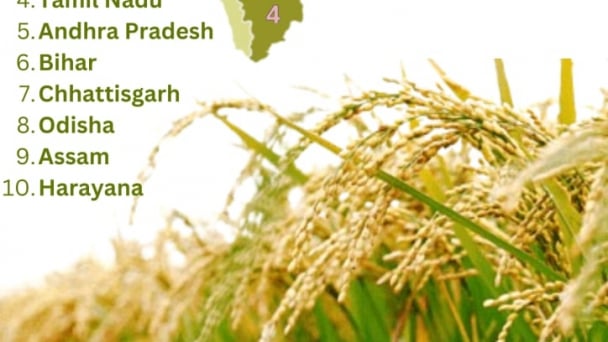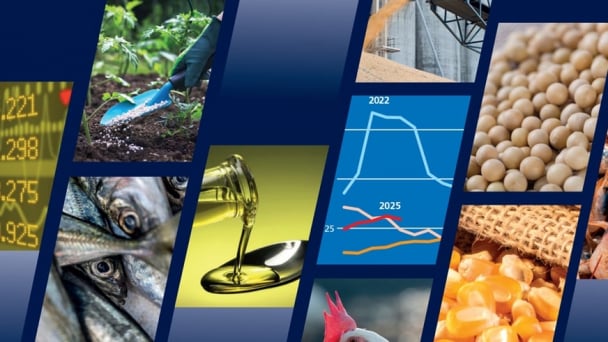June 22, 2025 | 17:48 GMT +7
June 22, 2025 | 17:48 GMT +7
Hotline: 0913.378.918
June 22, 2025 | 17:48 GMT +7
Hotline: 0913.378.918
Driven by increasing demand for citrus fruits in China, the market is expected to continue an upward consumption trend over the next decade. Market performance is forecast to decelerate, expanding with an anticipated CAGR of +1.8% for the period from 2024 to 2035, which is projected to bring the market volume to 56M tons by the end of 2035.
In value terms, the market is forecast to increase with an anticipated CAGR of +2.1% for the period from 2024 to 2035, which is projected to bring the market value to $71B (in nominal wholesale prices) by the end of 2035.
China's Consumption of Citrus Fruit
In 2024, consumption of citrus fruits decreased by -1% to 46M tons, falling for the second consecutive year after two years of growth. The total consumption volume increased at an average annual rate of +3.3% over the period from 2013 to 2024; however, the trend pattern indicated some noticeable fluctuations being recorded throughout the analyzed period. The pace of growth was the most pronounced in 2019 when the consumption volume increased by 8.3% against the previous year. Over the period under review, consumption hit record highs at 47M tons in 2022; however, from 2023 to 2024, consumption stood at a somewhat lower figure.
The value of the citrus fruit market in China declined modestly to $56.7B in 2024, which is down by -3.8% against the previous year. This figure reflects the total revenues of producers and importers (excluding logistics costs, retail marketing costs, and retailers' margins, which will be included in the final consumer price). Over the period under review, the total consumption indicated a moderate increase from 2013 to 2024: its value increased at an average annual rate of +3.9% over the last eleven-year period. The trend pattern, however, indicated some noticeable fluctuations being recorded throughout the analyzed period. Based on 2024 figures, consumption increased by +1.2% against 2022 indices. Citrus fruit consumption peaked at $62.1B in 2021; however, from 2022 to 2024, consumption stood at a somewhat lower figure.
Consumption By Type
Tangerines, mandarins, clementines, satsumas (26M tons) constituted the product with the largest volume of consumption, accounting for 56% of total volume. Moreover, tangerines, mandarins, clementines, satsumas exceeded the figures recorded for the second-largest type, oranges (7.6M tons), threefold. Citrus fruits not elsewhere classified (5.5M tons) ranked third in terms of total consumption with a 12% share.
From 2013 to 2024, the average annual growth rate of the volume of tangerines, mandarins, clementines, satsumas consumption amounted to +5.3%. With regard to the other consumed products, the following average annual rates of growth were recorded: oranges (+0.4% per year) and citrus fruits not elsewhere classified (+1.5% per year).
In value terms, tangerines, mandarins, clementines, satsumas ($25.9B) led the market, alone. The second position in the ranking was held by citrus fruits not elsewhere classified ($9.2B). It was followed by oranges.
From 2013 to 2024, the average annual growth rate of the value of tangerines, mandarins, clementines, satsumas market totaled +4.2%. With regard to the other consumed products, the following average annual rates of growth were recorded: citrus fruits not elsewhere classified (+3.4% per year) and oranges (-0.2% per year).
China's Production of Citrus Fruit
After three years of growth, production of citrus fruits decreased by less than 0.1% to 48M tons in 2024. The total output volume increased at an average annual rate of +3.3% over the period from 2013 to 2024; however, the trend pattern indicated some noticeable fluctuations being recorded throughout the analyzed period. The most prominent rate of growth was recorded in 2019 when the production volume increased by 8.2% against the previous year. Citrus fruit production peaked at 48M tons in 2023, and then dropped in the following year. Citrus fruit output in China indicated a tangible expansion, which was largely conditioned by noticeable growth of the harvested area and a relatively flat trend pattern in yield figures.
In value terms, citrus fruit production contracted modestly to $59.6B in 2024 estimated in export price. Overall, the total production indicated measured growth from 2013 to 2024: its value increased at an average annual rate of +4.3% over the last eleven-year period. The trend pattern, however, indicated some noticeable fluctuations being recorded throughout the analyzed period. Based on 2024 figures, production increased by +4.2% against 2022 indices. The most prominent rate of growth was recorded in 2017 when the production volume increased by 33% against the previous year. Citrus fruit production peaked at $66.8B in 2021; however, from 2022 to 2024, production remained at a lower figure.
Production By Type
Tangerines, mandarins, clementines, satsumas (27M tons) constituted the product with the largest volume of production, comprising approx. 57% of total volume. Moreover, tangerines, mandarins, clementines, satsumas exceeded the figures recorded for the second-largest type, oranges (7.6M tons), fourfold. Citrus fruits not elsewhere classified (5.5M tons) ranked third in terms of total production with a 12% share.
From 2013 to 2024, the average annual rate of growth in terms of the volume of tangerines, mandarins, clementines, satsumas production stood at +5.2%. With regard to the other produced products, the following average annual rates of growth were recorded: oranges (+0.4% per year) and citrus fruits not elsewhere classified (+1.5% per year).
In value terms, tangerines, mandarins, clementines, satsumas ($26.6B) led the market, alone. The second position in the ranking was taken by citrus fruits not elsewhere classified ($9.5B). It was followed by oranges.
From 2013 to 2024, the average annual growth rate of the value of tangerines, mandarins, clementines, satsumas production totaled +3.9%. With regard to the other produced products, the following average annual rates of growth were recorded: citrus fruits not elsewhere classified (+4.5% per year) and oranges (-0.4% per year).
Yield
The average yield of citrus fruits in China fell to 15 tons per ha in 2024, therefore, remained relatively stable against the previous year's figure. In general, the yield, however, showed a relatively flat trend pattern. The most prominent rate of growth was recorded in 2015 with an increase of 5.2%. The citrus fruit yield peaked at 15 tons per ha in 2018; however, from 2019 to 2024, the yield failed to regain momentum.
Harvested Area
In 2024, the total area harvested in terms of citrus fruits production in China amounted to 3.2M ha, approximately mirroring 2023. The harvested area increased at an average annual rate of +2.7% over the period from 2013 to 2024; however, the trend pattern indicated some noticeable fluctuations being recorded in certain years. The pace of growth was the most pronounced in 2019 when the harvested area increased by 13%. Over the period under review, the harvested area dedicated to citrus fruit production reached the maximum at 3.3M ha in 2022; however, from 2023 to 2024, the harvested area stood at a somewhat lower figure.
China's Imports of Citrus Fruit
In 2024, citrus fruit imports into China reduced sharply to 305K tons, falling by -15.1% compared with the previous year. In general, imports, however, saw a prominent increase. The growth pace was the most rapid in 2016 when imports increased by 90%. Imports peaked at 567K tons in 2019; however, from 2020 to 2024, imports failed to regain momentum.
In value terms, citrus fruit imports reduced to $368M in 2024. Over the period under review, imports, however, recorded a strong expansion. The most prominent rate of growth was recorded in 2017 with an increase of 56%. Imports peaked at $633M in 2018; however, from 2019 to 2024, imports remained at a lower figure.
Imports By Country
In 2023, South Africa (188K tons) constituted the largest citrus fruit supplier to China, accounting for a 52% share of total imports. Moreover, citrus fruit imports from South Africa exceeded the figures recorded by the second-largest supplier, Egypt (61K tons), threefold. Australia (28K tons) ranked third in terms of total imports with a 7.8% share.
From 2013 to 2023, the average annual rate of growth in terms of volume from South Africa amounted to +14.5%. The remaining supplying countries recorded the following average annual rates of imports growth: Egypt (+31.6% per year) and Australia (+5.0% per year).
In value terms, South Africa ($190M) constituted the largest supplier of citrus fruits to China, comprising 45% of total imports. The second position in the ranking was taken by Australia ($53M), with a 13% share of total imports. It was followed by Egypt, with a 12% share.
From 2013 to 2023, the average annual growth rate of value from South Africa totaled +13.0%. The remaining supplying countries recorded the following average annual rates of imports growth: Australia (+6.5% per year) and Egypt (+30.5% per year).
Imports By Type
In 2023, oranges (205K tons) constituted the largest type of citrus fruits supplied to China, accounting for a 57% share of total imports. Moreover, oranges exceeded the figures recorded for the second-largest type, grapefruits (76K tons), threefold. Tangerines, mandarins, clementines, satsumas (63K tons) ranked third in terms of total imports with a 17% share.
From 2013 to 2023, the average annual rate of growth in terms of the volume of oranges imports totaled +8.9%. With regard to the other supplied products, the following average annual rates of growth were recorded: grapefruits (+15.0% per year) and tangerines, mandarins, clementines, satsumas (+17.3% per year).
In value terms, oranges ($215M) constituted the largest type of citrus fruits supplied to China, comprising 51% of total imports. The second position in the ranking was taken by tangerines, mandarins, clementines, satsumas ($97M), with a 23% share of total imports. It was followed by grapefruits, with a 22% share.
From 2013 to 2023, the average annual rate of growth in terms of the value of oranges imports totaled +7.2%. With regard to the other supplied products, the following average annual rates of growth were recorded: tangerines, mandarins, clementines, satsumas (+16.8% per year) and grapefruits (+14.5% per year).
Import Prices By Type
In 2023, the average citrus fruit import price amounted to $1,169 per ton, falling by -1.9% against the previous year. In general, the import price recorded a slight descent. The pace of growth was the most pronounced in 2017 when the average import price increased by 36%. Over the period under review, average import prices reached the maximum at $1,421 per ton in 2014; however, from 2015 to 2023, import prices stood at a somewhat lower figure.
Prices varied noticeably by the product type; the product with the highest price was citrus fruits not elsewhere classified ($2,201 per ton), while the price for lemons and limes ($1,002 per ton) was amongst the lowest.
From 2013 to 2023, the most notable rate of growth in terms of prices was attained by citrus fruits not elsewhere classified (+4.5%), while the prices for the other products experienced a decline.
Import Prices By Country
The average citrus fruit import price stood at $1,169 per ton in 2023, shrinking by -1.9% against the previous year. Overall, the import price saw a slight shrinkage. The most prominent rate of growth was recorded in 2017 an increase of 36%.
Over the period under review, average import prices hit record highs at $1,421 per ton in 2014; however, from 2015 to 2023, import prices remained at a lower figure. There were significant differences in the average prices amongst the major supplying countries.
In 2023, amid the top importers, the country with the highest price was Spain ($2,044 per ton), while the price for Egypt ($799 per ton) was amongst the lowest. From 2013 to 2023, the most notable rate of growth in terms of prices was attained by Lao People's Democratic Republic (+15.8%), while the prices for the other major suppliers experienced more modest paces of growth.
China's Exports of Citrus Fruit
In 2024, shipments abroad of citrus fruits increased by 33% to 1.6M tons, rising for the second consecutive year after two years of decline. Over the period under review, total exports indicated a temperate increase from 2013 to 2024: its volume increased at an average annual rate of +4.1% over the last eleven-year period. The trend pattern, however, indicated some noticeable fluctuations being recorded throughout the analyzed period. Based on 2024 figures, exports increased by +84.9% against 2022 indices. The most prominent rate of growth was recorded in 2016 when exports increased by 55% against the previous year.
Over the period under review, the exports hit record highs in 2024 and are expected to retain growth in the immediate term. In value terms, citrus fruit exports skyrocketed to $1.5B in 2024. The total export value increased at an average annual rate of +2.7% from 2013 to 2024; however, the trend pattern indicated some noticeable fluctuations being recorded throughout the analyzed period. The growth pace was the most rapid in 2020 when exports increased by 24% against the previous year. As a result, the exports attained the peak of $1.6B.
From 2021 to 2024, the growth of the exports remained at a lower figure.
Exports By Country
Vietnam (359K tons) was the main destination for citrus fruit exports from China, with a 29% share of total exports. Moreover, citrus fruit exports to Vietnam exceeded the volume sent to the second major destination, Russia (131K tons), threefold. The third position in this ranking was held by Kyrgyzstan (118K tons), with a 9.7% share.
From 2013 to 2023, the average annual rate of growth in terms of volume to Vietnam stood at +7.3%. Exports to the other major destinations recorded the following average annual rates of exports growth: Russia (-1.4% per year) and Kyrgyzstan (+26.4% per year).
In value terms, Vietnam ($392M) remains the key foreign market for citrus fruits exports from China, comprising 31% of total exports. The second position in the ranking was taken by Russia ($123M), with a 9.9% share of total exports. It was followed by Kyrgyzstan, with an 8.8% share.
From 2013 to 2023, the average annual growth rate of value to Vietnam totaled +12.3%. Exports to the other major destinations recorded the following average annual rates of exports growth: Russia (-1.1% per year) and Kyrgyzstan (+27.6% per year).
Exports By Type
Tangerines, mandarins, clementines, satsumas (1.1M tons) was the largest type of citrus fruits exported from China, accounting for a 67% share of total exports. Moreover, tangerines, mandarins, clementines, satsumas exceeded the volume of the second product type, grapefruits (191K tons), sixfold. The third position in this ranking was held by oranges (178K tons), with an 11% share.
From 2013 to 2024, the average annual rate of growth in terms of the volume of tangerines, mandarins, clementines, satsumas exports amounted to +3.3%. With regard to the other exported products, the following average annual rates of growth were recorded: grapefruits (+1.9% per year) and oranges (+6.6% per year).
In value terms, tangerines, mandarins, clementines, satsumas ($1.1B) remains the largest type of citrus fruits exported from China, comprising 68% of total exports. The second position in the ranking was held by oranges ($174M), with an 11% share of total exports. It was followed by grapefruits, with an 11% share.
From 2013 to 2024, the average annual rate of growth in terms of the value of tangerines, mandarins, clementines, satsumas exports amounted to +1.5%. With regard to the other exported products, the following average annual rates of growth were recorded: oranges (+5.3% per year) and grapefruits (+1.7% per year).
Export Prices By Type
The average citrus fruit export price stood at $952 per ton in 2024, shrinking by -7.1% against the previous year. Overall, the export price continues to indicate a mild contraction. The pace of growth appeared the most rapid in 2017 an increase of 52%.
The export price peaked at $1,509 per ton in 2020; however, from 2021 to 2024, the export prices remained at a lower figure. There were significant differences in the average prices for the major types of exported product.
In 2024, the product with the highest price was citrus fruits not elsewhere classified ($1,943 per ton), while the average price for exports of grapefruits ($866 per ton) was amongst the lowest. From 2013 to 2024, the most notable rate of growth in terms of prices was recorded for the following types: citrus fruits not elsewhere classified (+8.3%), while the prices for the other products experienced a decline.
Export Prices By Country
In 2023, the average citrus fruit export price amounted to $1,025 per ton, which is down by -13.3% against the previous year. Over the period under review, the export price recorded a relatively flat trend pattern.
The most prominent rate of growth was recorded in 2017 an increase of 52%. The export price peaked at $1,509 per ton in 2020; however, from 2021 to 2023, the export prices remained at a lower figure. There were significant differences in the average prices for the major overseas markets.
In 2023, amid the top suppliers, the country with the highest price was Hong Kong SAR ($1,696 per ton), while the average price for exports to Kazakhstan ($758 per ton) was amongst the lowest.
From 2013 to 2023, the most notable rate of growth in terms of prices was recorded for supplies to Hong Kong SAR (+6.1%), while the prices for the other major destinations experienced more modest paces of growth.
indexbox

(VAN) Last week, the U.S. Department of Agriculture (USDA) released its June World Agricultural Supply and Demand Estimates (WASDE), raising projections for both Indian rice production and U.S. rice imports for the 2025/2026 marketing year.
/2025/06/17/2344-1-131758_261.jpg)
(VAN) Amid tariff risks and growing trade barriers in the U.S. market, Australia is emerging as a promising destination to sustain the growth momentum of Vietnam's shrimp exports.
/2025/06/17/2013-1-nongnghiep-112009.jpg)
(VAN) This notable growth trend reflects the global taste for fresh, nutritious fruits and the expanding use of lychees across various sectors.

(VAN) The political and cultural insulation of Japan’s beloved grain is falling apart, and experts warn the country’s relationship with the staple will have to adapt.

(VAN) Noting risks, report examines impacts of avian influenza, changing trade patterns since 2022, fish fraud, and shipping industry’s net-zero goals.

(VAN) Mr. Tran Quang Bao, General Director of the Forestry and Forest Protection Department, met and worked with the International Wood Products Association to promote cooperation in the field of timber trade.

(VAN) China's outbound shipments of rare earths in May jumped 23% on the month to their highest in a year, though Beijing's export curbs on some of the critical minerals halted some overseas sales.